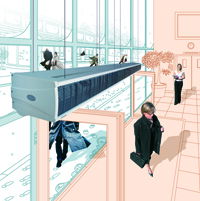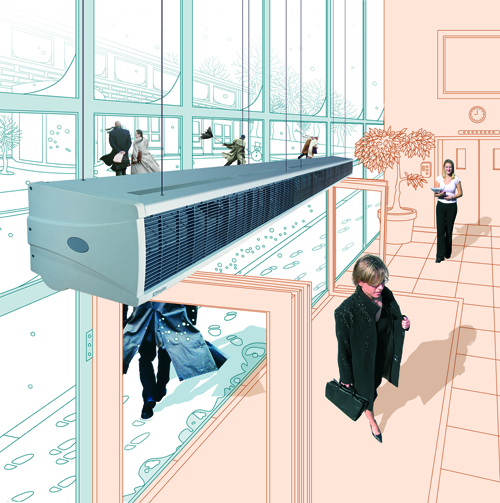Air curtains work by use a fast-moving airstream to ‘seal the gap’ created by open doorways, allowing buildings to hold on to treated air and ultimately reduce overall energy consumption.

Specified in a wide range of sectors including retail, healthcare and offices, they can reduce heat loss through doorways and service entrances whilst preventing cold air, insects, pollution and odours from entering the building. Air curtains are effective in summer too, maximising the performance of air conditioning systems by keeping treated, cooled air inside.
An increasingly popular energy saving solution for commercial sectors, they offer a low investment commitment and relative ease of installation – which is exactly why they should be part of any HVAC engineer’s offering.
Phil Chilton, commercial products manager for Dimplex, considers five steps to a successful air curtain installation.
- Full width airstream
The air curtain should be at least the same width as the door opening, ideally up to 100mm wider. Anything shorter than the open door width will result in gaps and reduce the efficiency of the product.
- Distance from opening
The closer the air curtain is installed to the doorway opening, the better. A gap of up to 100mm into the room from the opening façade will ensure the best results, and the air outlet should be positioned no more than 250mm from the top of the door.
- Measured air speed
Air curtains come in a variety of mounting heights, which will determine the air speed and can ensure a ‘seal’ right the way down to the floor. For the best results, the measured air speed 0.5m above the floor should be at least two metres/second, which is why high performance air curtains like the Dimplex DAB range are best suited for taller openings.
- Controls
A range of additional controls can help to reduce the running costs of any air curtain. Auto energy control, such as a door contacts, PIR sensors, weather compensation or a product which is linked to the Building Management System will offer the best performance. Alternatively, time or temperature controls can offer improved efficiency.
- Service and maintenance
Like any installed product, installation is just one part of ensuring optimum performance. An annual service is recommended for any air curtain, together with regular cleaning and maintenance as recommended by the manufacturer.
